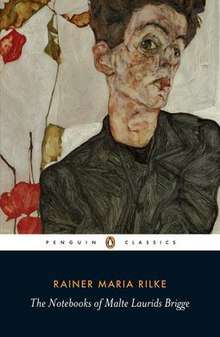The Notebooks of Malte Laurids Brigge
The Notebooks of Malte Laurids Brigge was Rainer Maria Rilke's only novel, and is said to have greatly influenced such other writers as Jean-Paul Sartre. It was written whilst Rilke lived in Paris, and was published in 1910. The novel is semi-autobiographical, and is written in an expressionistic style. The work was inspired by Sigbjørn Obstfelder's work A Priest's Diary and Jens Peter Jacobsen's second novel Niels Lyhne of 1880, which traces the fate of an atheist in a merciless world.
 | |
| Author | Rainer Maria Rilke |
|---|---|
| Original title | Die Aufzeichnungen des Malte Laurids Brigge |
| Translator | M. D. Herter Norton |
| Country | Austria-Hungary |
| Language | German |
| Genre | Autobiographical novel |
| Publisher | Insel Verlag |
Publication date | 1910 |
| Pages | Two volumes; 191 and 186 p. respectively (first edition hardcover) |
The book was first issued in English under the title Journal of My Other Self.[1]
See also
References
- M. D. Herter Norton (tr.). New York: W. W. Norton, 1949, 1992. Translator's Foreword, p. 8.
External links
| Wikiquote has quotations related to: Rainer_Maria_Rilke#The_Notebooks_of_Malte_Laurids_Brigge_(1910) |
- Die Aufzeichnungen des Malte Laurids Brigge at Project Gutenberg (in German)
- Original text at zeno.org (in German)
This article is issued from Wikipedia. The text is licensed under Creative Commons - Attribution - Sharealike. Additional terms may apply for the media files.